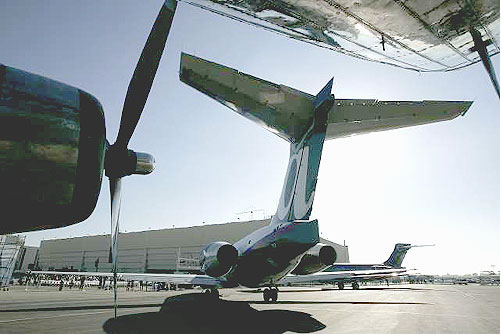Gasoline prices are still rising, with the national average for a gallon of regular self serve up 2 cents overnight at $2.72.
Easter holiday and spring break travel are driving up gasoline demand, assuring that prices will remain high through at least through this weekend.
Consumers in Bridgeport, California are hit the hardest at the pump with a gallon of regular costing $3.99. The cheapest gallon of regular on sale in the country costs $2.35 and can be found in Glasgow, Kentucky.

California: Gas prices have continued to rise in Southern California by almost a penny a day, and have come within 15 cents of last May's all-time record prices, according to the Automobile Club of Southern California.
Prices are rising on reports that even in April, American's demand for gasoline is nearing levels typically seen in mid-summer and that this year's hurricane season is expected to be active.
So, what are the reasons given for why California is paying more at the pump than the rest of the nation?
1. Early start of Daylight Savings Time has increased the amount of fuel being consumed. The opposite effect that was hoped for....we were supposed to save on energy by going to daylight savings time several weeks earlier. Instead of saving energy, apparently many Americans decided to take advantage of the extra daylight to drive MORE!
2. Supply and Demand. California's refineries are stretched to capacity, so any additional stress on the system drives supply down, and hence, prices go up. In addition, they are also saying it is a distribution problem, with most of the refineries and pipelines out of the state.
3. California's special blend, with its reduced levels of smog-producing ingredients such as aromatic hydrocarbons, adds about 10 cents a gallon to the cost of gasoline. Because California refineries don't make enough gas to answer the demand, the state must import gas from the few refineries — two on the Gulf Coast and a few overseas — that can make the special blend.
4. The cost of importing gasoline adds 10 to 15 cents a gallon to the price. It also makes gas prices in California more volatile, because instead of a steady stream of gas arriving via a pipeline, some days a lot of gas arrives and some days none arrives at all.
5. California's higher gas taxes add another approximately 13 cents per gallon, according to the American Petroleum Institute.
But right now gas is 60 cents more than the rest of the country. Where does the extra 22 to 27 cents come from? It looks like it's all about profit! 6. Profit. Sometimes (oil companies) make a lot of money because the market is really tight and demand pushes up the price. California Energy Commission data show that the average price for a branded gallon of unleaded was $3.08 on March 19, with a crude oil cost of $1.32 a gallon. The refineries' margins that day — their profits plus the cost of making the gas — were $1.12 a gallon. Compare that to March 20, 2006, when commission data show branded gas retailed for $2.64 a gallon, with a crude oil cost of $1.39 and the refineries' margins were 66 cents. 7. Refinery disruptions. Some of the current difference may be because of an unusual number of recent refinery disruptions. (These almost appear to be planned to hit when the demand is the highest) Each disruption further restricts the supply of available gasoline, helping keep prices high. Exxon Mobil Corp.'s refinery in Torrance, for instance, has been running below maximum capacity since February for maintenance. Then, on March 22, a unit shut down after a malfunction, a problem that will take a week or two to resolve. Other California refineries have had problems recently, with a fire in San Ramon-based Chevron Corp.'s Richmond refinery in January. Also, the refineries are switching from the winter blend of gas to the cleaner-burning summer blend. This disrupts supply because refineries let their supplies of the winter blend of fuel decline in anticipation of replacing them with the summer blend. Oil companies manipulate the price of oil so their profit and their stock will go up. There's no reason gas should be $3.40 a gallon when we were paying $2.40 a gallon in October, other than the fact that the oil companies can do i Exxon Mobil, the world's biggest publicly traded oil company, reported that profit rose 9 percent in 2006 to $39.5 billion, the largest annual profit by a U.S. corporation. Meanwhile, Chevron reported its best-ever annual profit in 2006, $17.1 billion, up 22 percent from 2005. What are your thoughts on this? Are we really paying the correct price at the pump, or are we being "fleeced"? If cleaner-burning fuel adds 10 cents, shipping costs 10 to 15 cents and taxes 13 cents, that accounts for 33 to 38 cents — and on average over the last five or six years, California gas has cost 20 to 25 cents more than the rest of the nation.
If cleaner-burning fuel adds 10 cents, shipping costs 10 to 15 cents and taxes 13 cents, that accounts for 33 to 38 cents — and on average over the last five or six years, California gas has cost 20 to 25 cents more than the rest of the nation.  t. The price of producing the gas hasn't gone up since then. The cost of crude oil hasn't changed appreciably.
t. The price of producing the gas hasn't gone up since then. The cost of crude oil hasn't changed appreciably.










No comments:
Post a Comment